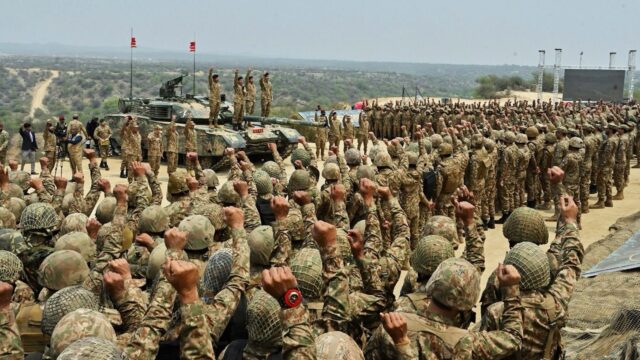India–Pakistan War: The Winners and the Losers

Chinese military hardware stole the show, French ones lost their stock, India’s clout took hits, and Pakistanis crowed. Yet, ultimately, the brief, hot India–Pakistan war was a victory only for the Global North’s divide-and-rule project for the Global South.
For all the alarming seriousness of two South Asian nuclear powers coming to the razor’s edge of a lethal exchange, the 2025 India–Pakistan war could not but contain elements of a Bollywood extravaganza.
Frantic dancing indeed, which risked getting out of control pretty fast. Forget dodgy, plodding UN mediation or any serious investigation of the suspicious attack out of the blue on tourists in India-held Kashmir.
Right off the bat, on 7 May, India’s Modi government dramatically launched ‘Operation Sindoor’ against Pakistan, a missile offensive billed as “counter-terrorism.” Pakistan immediately launched a counterpunch codenamed ‘Operation Bunyan al-Marsus’ against the “Indian invasion.”
Culture is key. Sindoor is classic Hindu culture, referring to the vermillion mark applied on the forehead of married women. No wonder the Chinese immediately translated it as ‘Operation Vermillion.’
Yet what the whole planet retained from the alarming escalation, irrespective of any attempt at contextualization, not to mention color-coded cultural practices, was the Top Gun element with a Bollywood twist: the Pakistani Air Force (PAF) and the Indian Air Force (IAF), on the night of 7 May, directly involved in the largest, and most high-tech air battle of the young 21st century, lasting a full hour and featuring scores of 4th and 4.5 generation fighter jets.
Dramatic entertainment value was provided, quirkily enough, not by Indians, but by a Chinese netizen, notorious internet blogger Hao Gege, and his hilarious global blockbuster parody video “The newly bought plane was shot down.” He was, of course, referring to the IAF’s French Rafales decimated by Chinese J-10C fighters, which have fully mastered electronic warfare and are equipped with cheap, precise, and brutally efficient PL-15 air-to-air missiles.
Add to it Chinese hardware such as the HQ-9 air defense system and ZDK-03 AWACS. A J-10C, which, incidentally, costs only $40 million, roughly six times less than a Rafale.
Inevitably, the whole thing turned into a public relations nightmare, not only for New Delhi, but mostly for the French military-industrial complex, complete with a cornucopia of spin from all sides. Islamabad claimed it destroyed six Indian fighter jets (including as many as three Rafales, with a collective price tag of $865 million, plus one Russian Su-30, one MiG-29, and one Israeli Heron UAV); paralyzed 70 percent of India’s power grid; and smashed India’s made-in-Russia S-400 defense system. India, for its part, fiercely denied all of the above over and over again.
Then, after so much sound and fury, Pakistan on 10 May announced it had won the war. Two days later, India announced the same.
The sound and fury though continued unabated, ranging from the J-10C basking in Top Gun superstar status and Chinese stocks skyrocketing in a much-vaunted “DeepSeek moment” in modern warfare to the ridiculous sight of US President Donald Trump claiming he was responsible for the India–Pakistan ceasefire, which as it stands, looks more like a pause.
Get a Rafale for the price of six J-10Cs
The fact is both Islamabad and New Delhi deployed a fast and furious arsenal of ballistic missiles, cruise missiles, glide bombs, and suicide drones to attack each other in a series of cross-border strikes, while at the same time confronted with the startling inneffectiveness of a great deal of their own air defense and anti-missile systems. No wonder both needed a ‘ceasefire’ – fast.
The predominant interpretation all across the globe does stand on solid facts. And those facts are profoundly game-changing: For the first time ever, Made-in-China weapons and equipment defeated similar-grade western weapons and hardware, not in a war gaming scenario, but in high-intensity air battle conditions. No amount of spin and glossy ads can compare with this practical demonstration by the Chinese military-industrial complex.
The J-10C, by the way, is not even a latest generation Chinese fighter; those would be the J-20 and J-35 (both 5th generation stealth fighters); the J-16 and J-15 (4.5 generation multirole fighters); and the 6th generation fighters (J-36 and J-50) still being tested.
Arguably, one of the best, concise explanations of the PAF/Chinese accomplishment was written by former PLA Air Force Colonel and strategist Professor Wang Xiangsui. He attributes it to a triad: mastery of systems warfare – as in highly integrated and synchronized Chinese air combat systems, Pakistani pilot competence, and preparedness for war. What PAF did, he reasons, emulates what China has been doing: investing in 6th-generation fighters, DF-17 missiles, and quantum satellites.
Further solid analyses by military expert Zhang Xuefeng and military expert Bai Mengchen complement in detail Wang’s conceptual framework.
When Hindutva meets Zionism
So what was this lightning war all about? It was not only about the intractable Kashmir problem inherited from the British Raj. As much as there are plenty of repulsive aspects inherent to both the Hindutva fanatics around Indian Prime Minister Narendra Modi and the ghastly Pakistani junta-in-charge who – illegally – imprisoned Pakistan’s sitting Prime Minister Imran Khan, such a war can only profit those usual suspects bent on unleashing various degrees of Hybrid War and Divide and Rule across the Global South.
Both India and Pakistan are permanent members of the Shanghai Cooperation Organization (SCO). Their dispute could have been managed at the SCO table, with Russia, China, and Iran present to mediate and placate. Instead, Moscow and Tehran acted independently and bilaterally, both trying their own way to instill some sense in the belligerents as mediators. Their success is debatable.
India is also – in theory – a top BRICS member, one of the founders of the multipolar powerhouse. It boasts an excellent strategic relationship with Russia and a geoeconomic relationship with the new BRICS+ West Asian power, Iran. To pit India against Pakistan is to pit New Delhi against Beijing, which fully supports Islamabad via the flagship New Silk Roads project, CPEC (China-Pakistan Economic Corridor). So the war can also be viewed as an attack on BRICS from the inside.
It was so easy to have both India and Pakistan’s so-called “elites” fall into the trap. One just needs to manipulate cheap “national pride” emotions – and the usual suspects are masters of that domain.
The Big Picture gets even murkier when we see that New Delhi, always insecure because, unlike the Chinese, it has not buried its own “century of humiliation” vis a vis Anglo power, is still wobbling between deeper geoeconomic integration with Russia – and China – while relying on defense and security from the Washington–Tel Aviv axis.
Hindutva and Zionism meet in more ways than one. India uses Heron and Searcher Israeli drones to patrol its borders, as well as Spike anti-tank missiles. Israeli advisors have trained Indian intel ops. Israeli cybersecurity firms help New Delhi track espionage threats and assorted “insurgencies.”
Junaid S. Ahmad, the director of the Center for the Study of Islam and Decolonization (CSID) in Islamabad, takes it a step further. He directly points to “Gaza in the Himalayas” – with the Modi government embroiled in a “fantasy war” over Kashmir.
With India importing vast swathes of war tech equipment, Ahmad argues, “Zionism and Hindutva do not merely share tactics – they share a cosmology: a belief that supremacy is sacred, and conquest is redemption,” with Muslims in Gaza branded as “Hamas sympathizers” finding the equivalent in Kashmiris branded as “terror-adjacent.”
Ahmad correctly identifies Hindutva as a “supremacist theology,” with a Hindu state “purified of difference – be it Muslims, Christians, or Dalits.” How can that possibly be accepted by the BRICS ethos?
The 2025 India–Pakistan war may go down in history because of the notorious air battle and the Bollywood antics – a messy post-modernist interpolation of tech warfare, psychological operations, information warfare, and cognitive dissonance. It stood casually, for a few days, as a global reality show and entertainment spectacular rather than an actual war. And that’s worrying enough, because it masks deep troubles inside systemically troubled India.
What does the Bharat concept – the new official name for India – really entail? Bharat refers to Emperor Bharata, identified as the first conqueror of the whole Indian subcontinent. Very Israeli-style, a Bharata Empire mural has since 2023 been showcased in the Indian Parliament, directly incorporating territories that belong to Pakistan and Bangladesh.
So what can be realistically interpreted as “terrorism” under a Bharat lens, really? All Kashmiris, Pakistanis, and Bangladeshis may be categorized as such? The actual leader of the Bharatiya Janata Party’s (BJP) parent organization, the Rashtrapati Bhagwat, insists that the “Bharata Empire” will inevitably come to fruition. In parallel, Indian media went into a frenzy promoting the independence of Balochistan from Pakistan.
https://thealtworld.com/pepe_escobar/india-pakistan-war-the-winners-and-the-losers
